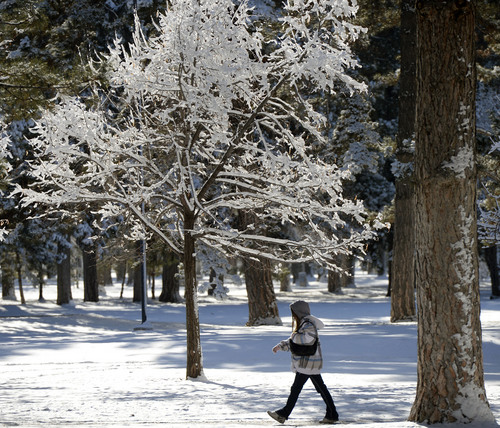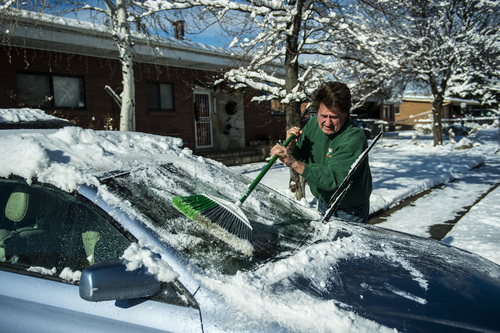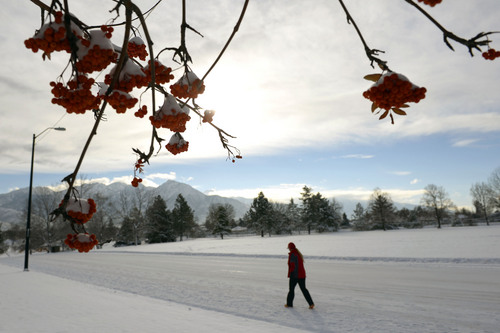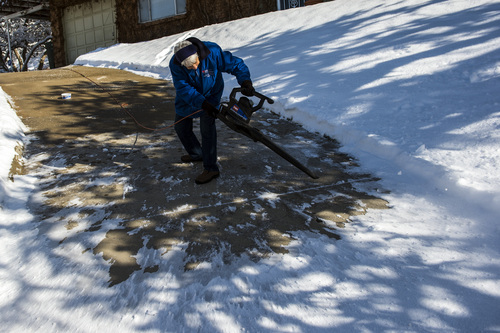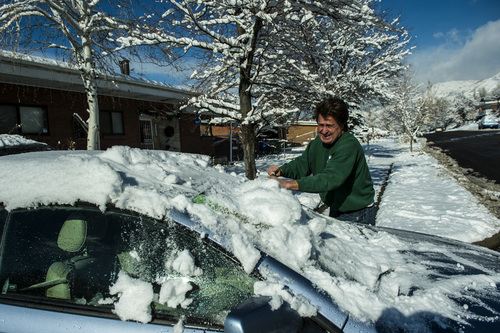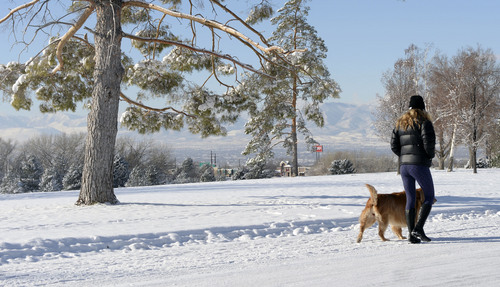This is an archived article that was published on sltrib.com in 2013, and information in the article may be outdated. It is provided only for personal research purposes and may not be reprinted.
Northern Utah will be in the deep freeze for the rest of this week, with temperatures dropping well below zero in the mountains and low teens in the valleys.
The National Weather Service warned that Thursday's lows will make the single digit and low teens of Wednesday look downright balmy by comparison. While Salt Lake City looked to reprise its overnight low of 10 degrees, the mountain communities of Park City (minus 5), Heber (minus 3), and Alta and Richfield (minus 2) were expected to be downright frigid at dawn Thursday.
It was to be colder elsewhere, with Soldier Summit sliding to minus 12, Randolph minus 11, Bear River minus 10. Even the lower-elevation communities braced for bone-chilling cold: Logan was to be just 2 degrees above zero, Cedar City 3 degrees, Provo 5, Tooele 8, Brigham City 10 and Ogden 11.
The usually much warmer residents of southwestern Utah's St. George were also bundling up ahead of Thursday's expected low of 19. The daytime high for Utah's Dixie? That will be 33, one degree above freezing.
It's where the mercury will tumble well below freezing that plumbing and heating repair businesses were anticipating busy days ahead.
"We haven't had any calls about broken or frozen water pipes so far today, but we expect to as this [cold spell] continues," said Tom Hicken, owner of Jerry's Plumbing Repair in Cache County's Hyde Park. "It's when the cold has been sustained for a few days that typically we'll start to get the calls."
Cache Valley expected low-single digit temperatures overnight through Sunday at least, with daytime highs in the teens and low 20s.
While not yet at record cold levels, the subfreezing temperatures in the Salt Lake Valley had employees of Neerings Plumbing, Heating and Air scrambling Wednesday, and owner Troy Neerings expected business to boom in the days ahead.
"Isn't this cold something? We're getting a lot of heating calls," he said. "The colder it gets, the longer and harder the furnaces have to work and they will break down or have problems. That's why it is so important to have preseason maintenance done."
Neerings said frozen or burst pipes also will likely be ahead for his crews as the cold snap extends through the coming weekend. Anticipating those calls, Neerings has been putting its employees through pipe-thawing and repair refresher courses this week.
The extreme cold, along with ice left by storms earlier this week, also continued to make travel of Utah's interstates treacherous, Utah Highway Patrol Sgt. Todd Royce warned.
"There's black ice, and drivers need to be aware that it is even colder and slippier in the canyons' shady spots," he said. "Also, our troopers are seeing more vehicles breaking down due to the cold, when people have neglected to check their antifreeze levels and their vehicles overheat and stall."
On Wednesday morning, as the cold spell settled in over the Wasatch Front, numerous crashes slowed an already crawling commute, Royce said. Nineteen crashes were reported by noon in Salt Lake County, but the roads remained clear and safe after that, Royce said.
Snowpacked road surfaces and patches of black ice prompted the Utah Department of Transportation to restrict travel in Big and Little Cottonwood canyons to four-wheel drive or tire-chain-equipped vehicles.
To the south in Utah County, eastbound U.S. 6 beginning at mile post 180 was restricted to tire chains for single-trailer semi rigs; multi-trailer semis were prohibited as Wednesday dawned. All vehicles were advised to use tire chains westbound on U.S. 6 beginning at mile post 210.
U.S. 191 was closed at the Utah-Wyoming border. Interstate 70 in Utah from Richfield to Green River began Wednesday closed to double and triple trailer semis.
The bulk of eastern Utah, where the Uintah School District canceled classes Wednesday, and the southwestern corner of the state as well remained under a Winter Storm Warning through 4 p.m. Wednesday. The National Weather Service said the central and southern mountains, along with the San Rafael Swell, western Uintas, Book Cliffs and Wasatch Plateau expected an additional 3 inches of snowfall through the day.
Several travel restrictions were in effect during the morning, but all roads were open without restriction by Wednesday night, UDOT confirmed.
Twitter: @remims —
Stay wise, warm and safe this winter
On the road and behind the wheel:
• Avoid driving while you're fatigued. Getting the proper amount of rest before taking on winter weather tasks reduces driving risks.
• Never warm up a vehicle in an enclosed area, such as a garage.
• Keep your gas tank at least half full to avoid gas line freeze-up.
• Do not use cruise control when driving on any slippery surface (wet, ice, sand).
• On long trips, watch weather reports prior to a long-distance drive or before driving in isolated areas. Delay trips when especially bad weather is expected. If you must leave, let others know your route, destination and estimated time of arrival.
• Pack a cellphone along with blankets, gloves, hats, food, water and any needed medication in your vehicle.
• If you become snowbound, stay with your vehicle. Tie a brightly colored cloth to the antenna or place a cloth at the top of a rolled-up window to signal distress. At night, keep the dome light on if possible.
• Make sure the exhaust pipe isn't clogged with snow, ice or mud. A blocked exhaust could cause deadly carbon monoxide to leak into the passenger compartment with the engine running.
• When driving in snow, accelerate and decelerate slowly. Applying the gas slowly to accelerate is the best method for regaining traction and avoiding skids. Drive slowly. Everything takes longer on snow-covered roads.
• The normal dry pavement following distance of three to four seconds should be increased to eight to 10 seconds. This increased margin of safety will provide the longer distance needed if you have to stop.
• Stay home. If you really don't have to go out, don't.
Source: AAA
... And at home:
• Make sure your furnace is properly maintained before cold weather hits. Begin the winter season with fresh filters and clean furnace areas.
• Sustained subfreezing temperatures can freeze and block water pipes and faucets. Properly insulating pipes, and where recommended using approved heat tape, can prevent expensive repairs.
• Pipes in attics, crawl spaces and outside walls are all vulnerable to freezing, especially if there are cracks or openings that allow cold, outside air to flow across the pipes.
• Holes in an outside wall where television, cable or telephone lines enter can also provide access for cold air to reach pipes. Such openings can be sealed with caulking or insulating materials.
• Leaving water running at a drip in sink or bathtub fixtures on especially cold nights can prevent frozen pipes.
• If you open a faucet and no water comes out, don't take any chances, call a plumber.
Source: Institute for Business and Home Safety —
Weather-related power outages •
Inclement weather has been blamed for power outages that left a few thousand Utahns in the dark.
About 900 Rocky Mountain Power customers in Taylorsville lost power from 10 p.m. to 11:30 p.m. Tuesday after a car on icy roads ran into a power pole, said power company spokeswoman Maria O'Mara.
On Wednesday morning, snow knocked out power for about 4,500 customers in Moab from about 8:10 p.m. to 9:10 p.m., O'Mara said.
Michael McFall


